#Mooreville
Explore tagged Tumblr posts
Text
Archovember 2024 Day 25 - Pteranodon longiceps
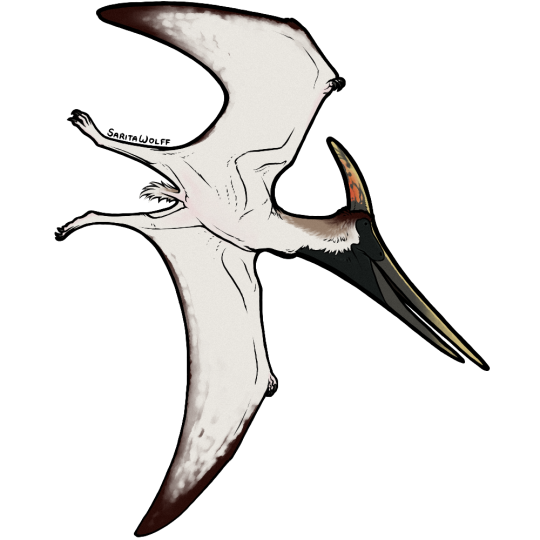
As one of the main species to make up the mythical “Pterodactyl” conglomerate, Pteranodon longiceps is possibly the most familiar pterosaur to the public. However, most people don’t know much about the real animal behind the pop culture monster. Living in the Late Cretaceous USA, Pteranodon is also the most well-known pterosaur to science, as over 1,200 specimens have been found! It was the first pterosaur found outside of Europe, the first toothless pterosaur found, and, before the discovery of the giant azhdarchids, was also the largest pterosaur known. Pteranodon is also one of the few prehistoric animals with confirmed sexual dimorphism, and it’s a bit extreme to boot! The larger male Pteranodons had huge pointed crests and an average wingspan of 5.6 m (18 ft), while the smaller female Pteranodons had small, rounded crests, wider pelvic canals, and an average wingspan of 3.8 m (12 ft).
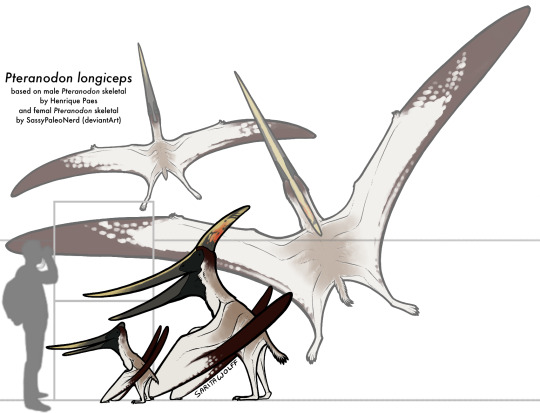
Pteranodon lived around the Western Interior Seaway, a massive sea that split North America in two during the Late Cretaceous into the Early Paleocene. With wings shaped like modern day albatrosses, Pteranodons were likely gliders who relied on thermals, but did seem to be more capable of sustained flapping. As one would expect, their diet was made up mostly of fish, though they may have eaten invertebrates as well. With their more heavy build, they could probably dive into the water like modern day gannets, folding up their wings and plunging beneath the waves, snatching up fish with their pointed, birdlike beaks. Pteranodon crests were most likely for display, as there was variation between not only males and females, but also individual males. As females were twice as common as males, they were probably polygynous, with males competing for the mating rights in rookeries of females. Competition was likely not physical, and instead would depend on females determining the age and fitness of males based on the size of their crest.
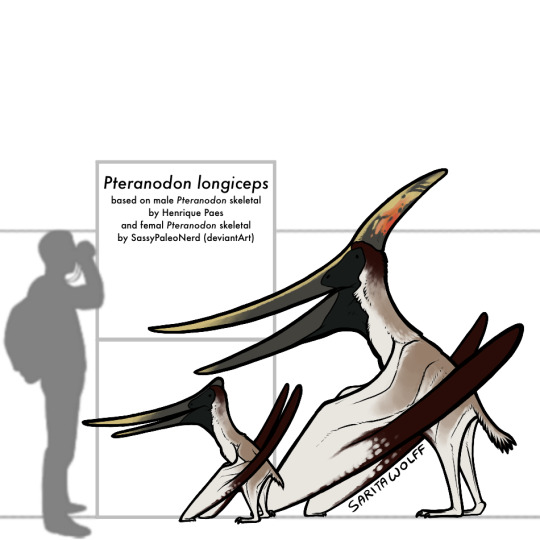
Pteranodon has been found in both the Niobrara Formation and the younger Pierre Shale Formation. Some possible fragments from the Mooreville Formation and Merchantville Formation also exist. While Pteranodon was much more common, it would have lived alongside, and possibly competed with, the fork-crested pterosaur Nyctosaurus and the toothed seabird Ichthyornis. It is probable that Pteranodon lived in offshore rookeries, raising their flaplings far from land-based predators, as most fossils are found far from what would have been the Interior Seaway’s coastline. Under the waves, Pteranodon would have hunted a variety of fish, ammonites, and squid. It would have come across sea turtles such as Toxochelys, plesiosaurs such as Styxosaurus, and flightless birds like Parahesperornis. It would have had to look out for mosasaurs like Tylosaurus and sharks like Cretoxyrhina. Aside from birds, most Pteranodons would rarely come across dinosaurs. Their main exposure to dinosaurs would be corpses, like that of the hadrosaur Claosaurus, being swept out to sea.

This art may be used for educational purposes, with credit, but please contact me first for permission before using my art. I would like to know where and how it is being used. If you don’t have something to add that was not already addressed in this caption, please do not repost this art. Thank you!
#Pteranodon longiceps#Pteranodon#pteranodontid#pterosaurs#archosaurs#archosauromorphs#reptiles#Archovember#Archovember2024#Dinovember#Dinovember2024#SaritaDrawsPalaeo#Late Cretaceous#USA#Niobrara Formation#Pierre Shale Formation#Mooreville Formation#Merchantville Formation
41 notes
·
View notes
Text

Dinovember 2024 Day 5: Hadrosaurus foulkii
This species, which measured 7-8 meters long, weighed about 2-4 tons, and lived about 80.5-78.5 million years ago on a coastal floodplain in what is now the Woodbury Formation of New Jersey, was in 1858 the first dinosaur ever to be described in the United States and North America from good fossil remains. Ten years later the only known specimen of Hadrosaurus foulkii became the first skeleton of a dinosaur ever to be mounted and put on display at a public institution-the Philadelphia Academy of Natural Sciences-by the renowned English naturalist-sculptor Benjamin Waterhouse Hawkins, who is also famous for designing the sculptures of dinosaurs and other prehistoric animals on the grounds of London’s Crystal Palace.
Hadrosaurus lends its name to the Hadrosauridae, the large, battery-toothed, herd-dwelling and hoof-toed ornithopods that dominated Laurasia and even Patagonia throughout the Late Cretaceous, and it was also part of a fauna of unique hadrosaurids that lived on the eastern Island continent of Appalachia. These included the 3-meter-long Claosaurus from the Niobrara Formation of Kansas, the basal Eotrachodon and the 4.5-meter-long Lophorothon atopus from the Moorevile Chalk Formation of Alabama, and the truly gigantic 10 to 17-meter-long Hypsibelma.
#paleoart#dinosaur#dinosaurs#paleontology#dinovember 2024#draw dinovember#dinovember#hadrosaurus#hadrosaurs#hadrosaur
76 notes
·
View notes
Text
Mooreville Plan By Pulte Homes in Westside Preserve in Midlothian TX in Midlothian ISD
ICYMI: http://dlvr.it/SrVMTz
0 notes
Link
1996 PETERBILT 379EXHD Year: 1996 Manufacturer: PETERBILT Model: 379EXHD VIN: 1XP5D69X6TN373762 Condition: Used Mileage: 1,780,000 mi Description: 1996, 379, 3 drivers in a lifetime of the truck interior is 9 out of...
0 notes
Photo

HERE ARE A FEW SIMPLE THINGS TO HELP SUPPORT YOUR LOCAL MEMBER OF HOPE CHURCH TUPELO MOOREVILLE, MISSISSIPPI AUTHOR. #1 BUY Brothers Divided by J.W. Worsham #2 WRITE a Review the book on Amazon.com, Barnes and Noble, iBooks, Goodreads, anywhere, it only takes 1 to 2 minutes #3 FOLLOW US on social media #4 POST about the book Online, Facebook, Instagram,Twitter #5 TELL a friend (or 20) about Brothers Divided by J.W. Worsham #6 ASK your local Libray to add Brothers Divided by J.W. Worsham to their collection. #7 SHARE post about Brothers Divided by J.W. Worsham on your social media pages. Click here to order your copy 📕 Xulon Press Publishing https://www.xulonpress.com/bookstore/bookdetail.php?PB_ISBN=9781545608296&HC_ISBN= #BrothersDivided #JWWorsham #SupportYourLocalAuthor #Mooreville #Tupelo #Paynes #Grenada #Mississippi #ThankYou #Sunday #Monday #Tuesday #Wednesday #Thursday #Friday #Saturday #HopeChurchTupelo (at Mooreville, Mississippi) https://www.instagram.com/p/B79pP91lcqM/?igshid=1t77rhg6xd9pn
#1#2#3#4#5#6#7#brothersdivided#jwworsham#supportyourlocalauthor#mooreville#tupelo#paynes#grenada#mississippi#thankyou#sunday#monday#tuesday#wednesday#thursday#friday#saturday#hopechurchtupelo
1 note
·
View note
Text
American Auto Trail-Bankhead Highway (Tombigbee River to Tupelo MS)
American Auto Trail-Bankhead Highway (Tombigbee River to Tupelo MS)--This route follows what was once the Bankhead Highway auto trail of the 1910s and 1920s, which later became U.S. Highway 78--https://youtu.be/ryLu3IcVLro
This route follows what was once the Bankhead Highway auto trail of the 1910s and 1920s, which later became U.S. Highway 78. We begin on the west bank of the Tombigbee River, opposite the town of Fulton. For more of our American Auto Trails and Slow Travels guides, available in print or eBook format, use one of the links below: Amazon Lulu Press Camera: Sony Active Camera FDR-X3000 Vehicle:…

View On WordPress
#american history#Auto trail#bankhead highway#chickasaw#Corridor X#Dorsey#Fulton#Harrisburg#Mantache#mississippi#Mobile Ohio#Mooreville#railroad#slow travel#Tombigbee#Tupelo#US 78
0 notes
Photo


Went out exploring and saw this old dilapidated house in Mooreville.
3 notes
·
View notes
Link
Home repairs and maintenance can be a painful, especially if you don’t have the proper tools, staff, knowledge or time to complete the project. Many times, home and business attempt to do a project themselves, thinking they will save a lot of money in the long run however time is money as well. They do not take into account the time they spent searching the internet, watching YouTube videos, driving to the home improvement store, buy the wrong supplies or not getting enough of what they need, etc. This process can be very tiresome and not to mention frustrating. And we won't even discuss the additional work that is required if you were to break or improperly install something along the way.
Call RJ Mooreville’s Handyman Services at 980-710-4418 or visit us on the web https://handymanservicemooresvillenc.com/
2 notes
·
View notes
Text
Paper summary: Harrell et al., (2016). Endothermic mosasaurs? Possible thermoregulation of Late Cretaceous mosasaurs (Reptilia, Squamata) indicated by stable oxygen isotopes in fossil bioapatite in comparison with coeval marine fish and pelagic seabirds.
[This paper is freely available, by the way!]
Hi all! This is the first in a new weekly series I’m going to be doing, in which I will be doing a short paper review each Thursday. We’re starting off big this week, with a delve into the world of stable isotopes.
But Hayley, you say, what in the world are stable isotopes?
Okay, time for some backstory!
The part with the backstory
Isotopes, as you may be aware, are atoms of the same element that have different numbers of neutrons, and therefore different atomic weights. If you think back to chemistry class, or forward to chemistry class if you haven’t taken it, in which case this might help you get a leg up, you’ll remember or just be learning that each element is defined by the number of (positively charged) protons in its nucleus. So each atom of carbon has 6 protons, and if it has more or less, then that’s a problem, because then it’s not carbon. But within the same element they can vary in numbers of (neutral) neutrons. Neutrons are important for holding together an atom’s nucleus, because if you get a bunch of positive charges together in a nucleus they start to repel, just like if you get a bunch of elementary school-aged children together. Different isotopes act basically the same, and I can guarantee you that right now some of the carbon atoms you are using in your body have six neutrons, some have seven, and some have eight. These are referred to as carbon-12, carbon-13, and carbon-14, respectively, and that number refers to the number of (protons+neutrons) in the nucleus. [Sometimes some isotopes are unstable and undergo radioactive decay. Carbon-14 does this. But that’s not really relevant to what we’re doing today.]
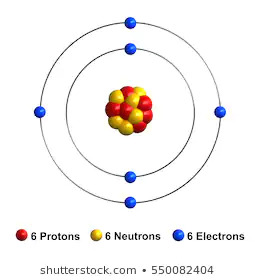
(Image: This is a carbon-12 atom. The yellow and red bits in the middle are the protons and neutrons. Not remotely to scale.)
Different isotopes of the same element act mostly the same (besides sometimes being radioactive and going berserk), so animals can take them up and use them. But they don’t act entirely the same, and that information can be used by palaeontologists to learn really cool stuff about past life.
A big thing that isotopes can do differently is something called mass-dependent fractionation. That’s fancy-people-speak for “it’s easier to move things that are less heavy”, and it means that it’s easier to move things that are less heavy.
One useful aspect of this deals with oxygen isotope fractionation. You are breathing oxygen as you read this, and if you are not then you will not likely be reading this for very much longer. Oxygen is also present in water, though, and water covers 70% of the Earth’s surface and makes up 70% of your body. It’s kind of a big deal, if you’ve never heard of it, and for our purposes it comes in two main flavours - water with oxygen-18, and water with oxygen-16.
Oxygen-16 makes up 99.76% of all oxygen on earth, and oxygen-18 makes up 0.2% (the rest is oxygen-17, which no one cares about). This means that about 0.2% of water is heavier than the rest of water. This water is harder to move, because it’s heavier, and when evapouration occurs, oxygen-16 is more likely to evapourate because it takes less energy to move it.
But wait! Putting in more energy makes it easier to move heavy things, and this is exactly what happens. If temperatures are warmer, more oxygen-18 gets evaporated than does at colder temperatures.
We need something to compare this to, because otherwise we’d just be measuring samples and it’d be hard to know what different numbers are referring to. For oxygen, we use the standard of Vienna Standard Mean Ocean Water, or V-SMOW. It’s not super important to know what that is.
What is important is delta notation: δ18O (delta-eighteen-O) refers to how different the ratio of oxygen-18/oxygen-16 is from the standard. We use the symbol ‰, “per mil”, which is fancy people talk for 0.1%, for this, because the differences are really little. +1‰ means that there’s 0.1% more oxygen-18 in the sample than normal - that is, it’s 0.1% “heavier” than normal water.
So, to get that all neatly said: Higher temperatures = More heavy water evapourates = the water that is left behind is lighter.
The part with the actual paper
Oh yeah, the paper! That’s why we were here. Okay, so mosasaurs were a group of big marine lizards (not dinosaurs) in the Cretaceous period. I wrote a little about them here. They looked kinda like this, and could get up to 17m/55ft long.

(Image: A mosasaur, a streamlined marine reptile with a large head, flippers, and a vertical tail fin. Image by Dimitry Bogdanov.)
Being lizards, mosasaurs have been traditionally thought to be cold-blooded - perhaps a reasonable assumption, as all living lizards are cold-blooded. However, it has been suggested various times in the literature as well as informally that mosasaurs may have been warm-blooded, owing to their assumed ecology as fast-moving pursuit predators and the fact that other marine reptiles have been demonstrated to be warm-blooded.
In order to quantitatively test this, teeth from three species of mosasaur from the Mooreville Chalk in Alabama were collected and analysed to find the isotopic composition of oxygen. We need a control sample, though, to ensure that some geological process or change in atmospheric oxygen won’t mess up our data by adding or removing some heavy oxygen. In order to do this, the authors also tested samples from fish, turtles, and aquatic toothed birds that lived at the same time and place. That way they could place the mosasaur fossils in a reliable context.
And the results they found are really interesting!
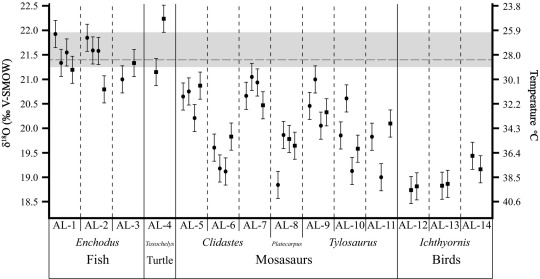
(Image: a graph showing δ18O values of different fossils from the Mooreville Chalk. I’ll do my best to explain what’s going on in the following paragraphs.)
Okay, so first things first. The fish and turtles tested have very similar δ18O values to each other. They both fall around the +21.2 to +22.0‰ range, or 2.12% to 2.2% heavier than “normal” water (because the “lighter” water has evapourated and left). This corresponds to a temperature of about 26-29°C (79-84°F). This is consistent with estimates of the temperature of the formation. This is what we expect from cold-blooded animals. Good! The method works!
Okay, next step. We can pretty safely assume that these birds were warm-blooded, and thus had a higher body temperature than their environment. Those tested had a δ18O value of about +18.5 to +19.5‰. That’s still heavier than normal water, but it’s less heavy than the cold-blooded animals (because the higher body temperatures led to more of the “heavy” water evapourating and leaving the body). This corresponds to body temperatures in the range of 36-39°C (97-102°F). This is right in the range of modern warm-blooded animals, and it’s another verification that the method works.
Okay, so what do the data say about mosasaurs? Well, it’s kind of a broad scatter. The δ18O values of the samples fall in the range of +19 to +21‰, which corresponds to a range 30-38.5°C (86-101°F). In other words, we’re getting body temperatures that are consistently warmer than the environment or cold-blooded animals, and in some cases are as warm as birds from the same environment!
What can we conclude from this? We can conclude that mosasaurs were probably warm-blooded, or, from the fact that some fall between the two, maybe “lukewarm-blooded” (which I wrote a bit about here). Either way, don’t think you’re safe just because it’s cold.
166 notes
·
View notes
Photo

Got my trusty sidekick helping me making #trunkortreat bags. #childlabor nawwwww! He loved it! #trunkortreat2018 #livingwatercommunitychurch #mooreville #ms https://www.instagram.com/p/BplRxqDl0K_/?utm_source=ig_tumblr_share&igshid=1m1rlrlnqjzg6
0 notes
Text
Teapot Tuesday - When Friends Look Out For You
Teapot Tuesday – When Friends Look Out For You
I say it all of the time but I really mean it. I have the best friends in the entire world. The teapot featured today is new to me but has been in a collection for awhile. My friend, “Cotton” Ketchie is downsizing and will be closing his gallery -Landmark Galleries – located in Mooresville, NC in the near future. Along with his extensive offerings of his own artwork and photography he also…
View On WordPress
#"Cotton" Ketchie#blue teapots#Landmark Galleries#Mooreville#NC#NC teapots#pottery teapots#teapot#teapot collection#teapot Tuesday
0 notes
Text
Mooreville Plan By Pulte Homes in Westside Preserve in Midlothian TX in Midlothian ISD
ICYMI: http://dlvr.it/SrTsM6
0 notes
Photo

Have you ever wondered "Where can I get a copy of Brothers Divided by J.W. Worsham?" Brothers Divided is AVAILABLE at Xulon Press Publishing, Amazon, Barnes and Noble, & iTunes. ALSO, DOWNLOADABLE for Kindle, Nook, and iBook. Click on or Copy & Paste one of the links below to order your copy of Brothers Divided by J.W. Worsham. . 📕Xulon Press https://www.xulonpress.com/bookstore/bookdetail.php?PB_ISBN=9781545608296&HC_ISBN= . 📙Amazon also for Kindle https://www.amazon.com/Brothers-Divided-J-W-Worsham/dp/1545608296/ref=mp_s_a_1_1?keywords=Brothers+Divided+by+J.W.+Worsham&qid=1576242852&sr=8-1 . 📗Barnes & Noble also for Nook https://m.barnesandnoble.com/w/brothers-divided-jw-worsham/1126586711?ean=9781545608296 . 🍎 iTunes iBook https://itunes.apple.com/us/book/brothers-divided/id1249314331?mt=11 . #BrothersDivided #JWWorsham #Author #Book #Mooreville #Paynes #Tupelo #Grenada #BookReviews #moorevilletroopers #Mississippi #HopeChurchTupelo #SupportLocalAuthor #xulonpress #Amazon #kindel #BarnesandNoble #Nook #iTunes #iBook #GoodReads #FiveStarReview #review #reviews #EnterToWin (at Mooreville, Mississippi) https://www.instagram.com/p/B75s2gRlRV2/?igshid=sa7w1qddnwpo
#brothersdivided#jwworsham#author#book#mooreville#paynes#tupelo#grenada#bookreviews#moorevilletroopers#mississippi#hopechurchtupelo#supportlocalauthor#xulonpress#amazon#kindel#barnesandnoble#nook#itunes#ibook#goodreads#fivestarreview#review#reviews#entertowin
1 note
·
View note
Photo

We’ll be feeding the wonderful teachers in Mooreville today so we’ll be closed to the public. https://www.instagram.com/p/CVKx2M9DO98/?utm_medium=tumblr
0 notes
Photo

2021 Miss St. College World Series National Champions tribute putter. One of the more unique TeI3 makeovers we've ever done. Putter is basically brand new with new shaft, new grip, and of course the "Hail State" custom stamping. #scottycameron #customputters #putterporn #mississippistate (at Mooreville, Mississippi) https://www.instagram.com/p/CRr-efPNZwJ/?utm_medium=tumblr
0 notes
Link
RJ Mooreville’s Handyman is your local, trusted handyman. Our services include anything from hanging pictures to building you a shed. We also offer a variety of other services such as furniture assembly, tree trimming and window screens.
Need a pro for your project? Give us a call!
1 note
·
View note